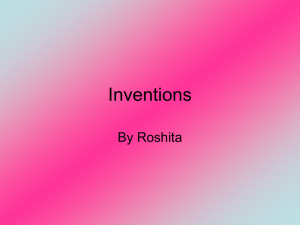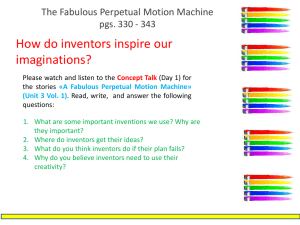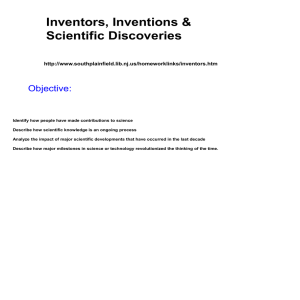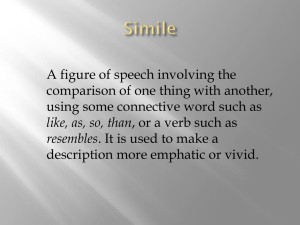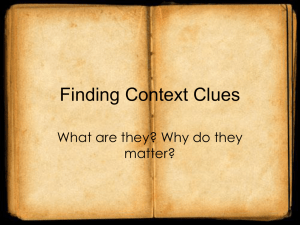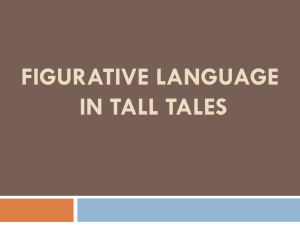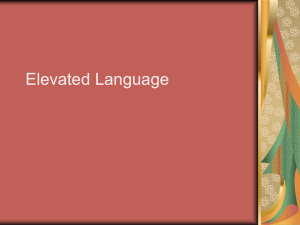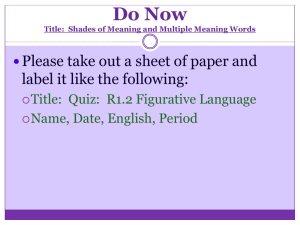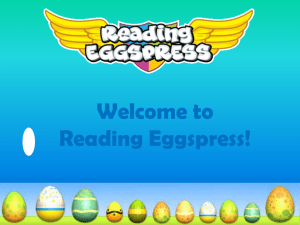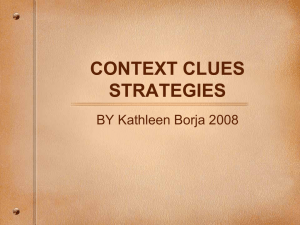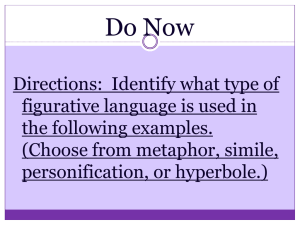PowerPoint
advertisement
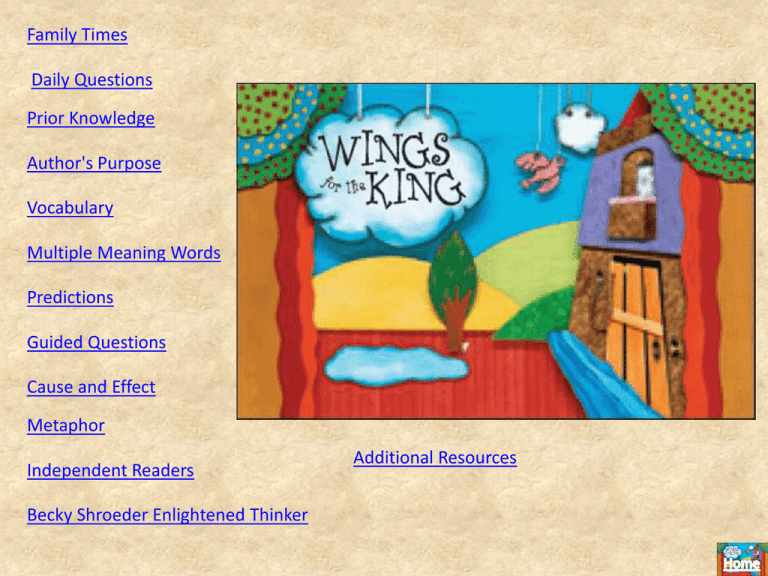
Family Times Daily Questions Prior Knowledge Author's Purpose Vocabulary Multiple Meaning Words Predictions Guided Questions Cause and Effect Metaphor Independent Readers Becky Shroeder Enlightened Thinker Additional Resources Study Skills: Genre: Play Vocabulary Strategy: Context Clues (Multiple Meaning Words) Comprehension Skill: Author’s Purpose Comprehension Strategy: Story Structure Question of the Week: How do inventors inspire our imaginations? Daily Questions: Why does the King wish to fly so much? How is reading a book like taking a journey? Does Becky inspire you to try and invent something from your ideas? Why or why not? Activate Prior Knowledge Inventors K W Inventors have good imaginations. What does it take to be an inventor? Thomas Edison was a famous inventor. What are the most important inventions ever made? L Author’s Purpose • The author’s purpose is the reason or reasons an author has for writing. The purpose may change during a selection, but most selections have one main purpose. • An author may write to persuade you, to inform you, to entertain you, or to express ideas or feelings. The kinds of ideas and the way the author states them help you see the author’s purpose. Kinds of Ideas Ways ideas are stated Author’s Purpose (s): Persuade Inform Entertain express Story Structure: Active readers pay attention to story structure for clues about the author’s main purpose. Generally, authors identify the problem of the main character at the start. They work through the problem as the action rises in the middle, and then solve it with the climax and outcome. WRITE: 1. Read “Minnie Miller, Millionaire.” Use the graphic organizer above to give the author’s main purpose for writing and two ideas from the story that support your answer. 2. Write a paragraph telling what you think the author’s main purpose was for writing “Minnie Miller, Millionaire” and how the author achieved that purpose. Word Meaning Admiringly With wonder permit allow scoundrel subject worthless Sentence Tom looked admiringly at his big brother. My parents permit me to stay up until 9:00. Admiringly With wonder, pleasure, and approval Permit To let; allow Scoundrel An evil, dishonorable person Subject Person under the power, control, or influence of another. Worthless Without value; good-for-nothing; useless More Words to Know Parapet: a low wall at the edge of a balcony, roof, or bridge Reproachfully: with disapproval Practice Lesson Vocabulary: Does the King permit visitors? Is Geraldine Kronmiller a royal subject? Are Tina Applegate’s wings worthless when it comes to flying? The King listened to the stories _________________________. As soon as the King would _____________, the Page would start talking. The King threw the first and second _________________ into the dungeon. Vocabulary Strategy (p. 264) Context Clues (Multiple Meaning Words) Some words have more than one meaning. Use words and sentences around the word with multiple meanings to figure out which meaning the author is using. 1. When you are puzzled by a multiple-meaning word, read the words and sentences around it to get the context for the word. 2. Then think about the different meanings the word has. For example, direct can mean “to manage,” “to command,” and “to show the way.” 3. Reread the sentence, replacing the word with one of the meanings. 4. If this meaning does not work, try another one. As you read “Heroes and Dragons,” use the context and your knowledge of the word to decide which meaning a multiple-meaning word has. For example, does permit mean “to allow” or does it mean “a license”? Genre: Play A Play is a story written to be acted out for an audience. As you read, imagine the actors speaking the lines and acting out the action. Who will show the King the secret of flying? Preview and Predict Look at the title, illustrations, and other external story structure features like the cast of characters, speech tags, and stage directions. Predict what the play is about. Use you vocabulary words when forming your predictions. Guided Comprehension: What do we know about the King? What do you think the author’s purpose is for writing Wings for the King? How do you know? When the King commands that someone make him wings, what effect does it have on the others? What words would you use to describe the King? Describe how this play is similar to and different from other plays you’ve read. Think about structure, characters, and plot. How do the stage directions add to the play’s humor? What does the Queen’s dialogue tell you about her personality? Compare Tina’s invention to Geraldine’s invention. Guided Comprehension Continued What effect do you think the two failed inventions will have on the King? Use context clues to determine the meaning of skip at the end of p. 275. Why do you think Isaac Summerville brought books to the King? What do the books symbolize? Explain what you think the author’s purpose is on p. 276-277. The word page has multiple meanings. Use context clues to contrast the meaning of page in the second line of p.278 with the character called Page. Describe a time when you read something that took you on a journey to the “land of knowledge.” Cause and Effect (TM 271) • Clue words often signal a cause and effect relationship. • Clue words aren’t always included. Sometimes a reader has to infer the relationship. Write a sentence about a cause-effect relationship in the play using one of the words: because, so, or since. Metaphor: A metaphor is a comparison between two unlike things that are alike in at least one way. • The similarity in a metaphor is implied. There are no comparison words such as like or as. • While a simile says that one thin is like something else, a metaphor says that one thing is something else. • A symbol is a person, place, or object that has meaning in itself but suggests other meanings as well. Reread Isaac’s third line on p. 277. Notice the metaphor comparing books to wings. Locate the metaphor in Isaac’s first line on p. 278: “Reading is discovering…” and write about what is being compared. 1. What is being compared? 2. Why is this a metaphor and not a simile? SUMMARY The author offers a brief history of the development of flight, from the drawings of Leonardo da Vinci to the use of the Concorde. She describes many uses of flight, including mail delivery, passenger service, and weapons transport. COMPREHENSION QUESTIONS PAGE 8 What did the Wright brothers do when they failed in one of their tests or experiments? PAGE 12 What conclusion can you draw about the effect of World War I on the development of aviation? PAGE 15 What is the author’s purpose in telling readers about Amelia Earhart? PAGE 23 Summarize the major developments in aviation since the Wright brothers’ 1903 controlled airplane flight. SUMMARY Kids have created inventions dating from 5,000 years ago. This book describes five such inventions and explains the process for getting a patent. The book invites students to invent too. COMPREHENSION QUESTIONS PAGE 5 How did Hsi Ling Shi invent silk? PAGE 6 How did Chester Greenwood invent earmuffs? PAGES 8–9 Why did Jeanie Low invent a stool that folded? PAGE 11 Why do inventors need patent lawyers? PAGE 13 What motivated Josh Parsons to invent? PAGE 17 What is the author’s purpose in including a flow chart? SUMMARY The author describes a variety of aspects of the patent process. She explains why people need patents, how people get patents, and what patents are used for. The author also refers to some well-known inventions that have been patented and describes the work of prominent inventors. COMPREHENSION QUESTIONS PAGE 5 What reasons might people have for wanting exclusive rights to their inventions? PAGE 9 Based on the sketch prepared and submitted by Alexander Graham Bell, what generalization can you make about the level of detail needed in inventors’ sketches when they apply for patents? PAGE 10 What seems to be the author’s purpose? PAGE 19 Examine the chart. What does the structure of the chart allow the reader to do? Narrative Nonfiction: •Narrative Nonfiction tells the true story of an event that takes place over a certain period of time, anywhere from minutes to years. •This event may come from one person’s life, or it may involve several people, places, and things. Text features: •The event is usually told in chronological order, from start to finish. •Narrative nonfiction sometimes contains quotes from the people involved. •Look at the title and illustrations to get an idea of who and what this selection deals with. What do you think the selection is about? Why do you think some words appear in different print? Is the author trying to inform or entertain? What clues tell you that sequence is the text structure? How do the illustrations help make things clearer? Compare the King and Becky Schroeder. Were they both inventors? What goals did they have in mind? What methods did they use for achieving them? Present you answers in two separate paragraphs. Additional Resources: Homograph Game Context Clues Cause and Effect Author's Purpose Metaphors Metaphors 2
